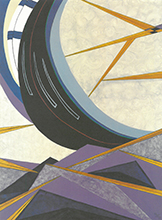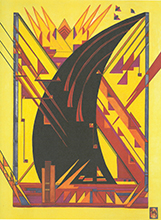The Unfinished Business of Ron Goldfarb: A Return to Art
While attending an art auction in New York, Ron Goldfarb couldn’t help but get caught up in the excitement of magnificent artwork and six-figure bids. At the crack of the gavel—SOLD—Goldfarb realized he wanted to be the artist behind the painting. After retiring from a long, successful legal career, he unleashed his creativity onto canvas.
“With paintbrush in hand, daybreak and sunrise came unnoticed. What sense of color, what rhythm of line would my inner self select to complete the painting? I was consumed with excitement and wonderment,” said Goldfarb (BA ‘52, social sciences).
In a rush of inspiration, Goldfarb had soon completed enough paintings to hold his first solo exhibition. As a relatively unknown artist, he sold his first painting within the first 20 minutes of opening night and three more over the course of the evening. Followed not long after by several more art expositions and gallery shows in Connecticut, New York, Philadelphia, and Boca Raton. An overnight success, his work earned positive reviews from the art community.
“I am grateful that both courtroom juries and the jury of art critics and the general public have both been very kind and rewarding.”
It was as if Goldfarb had been bottling up this creativity and energy for many years, and he had finally hit a point in his life when he could no longer keep a lid on it.
In high school, Goldfarb never dreamed he would be able to afford to go to college. But thanks to a track scholarship, he enrolled at the University of Denver in 1948. Like so many others, he wasn’t entirely sure what he wanted to do.
An advisor encouraged Goldfarb to take an aptitude test to help uncover his natural talent and strengths. He was drawn to spatial relationships, balance and geometric design, and thought he might like to be an architect. However, the test indicated he was best suited for medicine or law.
After considering these recommendations, Goldfarb concluded that he preferred the logic and reasoning of law to the memorization of medicine. He abandoned his pursuit of architecture and began taking courses in political science, economics, sociology, and psychology in preparation for law school.
Goldfarb said his years at DU prepared him for more than that. It was a place where he met people from across the country and the globe, making friends with students from California, New York, Illinois, Massachusetts, Canada, and Iraq who helped broaden his own perspective. Friends he still keeps in touch with, even though their college years are far behind them.
His college experience not only prepared him for his future career, but also taught him life skills. Learning about psychology, persuasion, and how to deal with others served him well in the courtroom. Working multiple jobs, after losing his scholarship to injury, helped Goldfarb develop the strong work ethic that led him to success in his career and pro bono legal service.
“My experience was happy and rewarding. It taught me the real meaning of education and was very formative,” said Goldfarb.
After DU, Goldfarb went on to complete law school. Over the course of his career as a litigator and trial lawyer, he tried and won difficult, complicated cases, some of which drew national attention. A few of his cases involving medical malpractice, public housing supervision, and patch testing have been incorporated into the curriculum of law schools across the country.
A testament to his ability, he was appointed to serve as the Governor of the New York State Trial Lawyers Association by the president of the bar association and as Special Referee by the chief justice of the New York Supreme Court, and has also presented at numerous lectures and seminars.
In addition to his regular work load, Goldfarb took on a number of pro bono cases over the years, including a case advocating for beach restoration and another for guardrails to improve highway safety.
“After one of my cases, I received a letter from my client thanking me for what I did and telling me how important it had been to him and his family,” Goldfarb said. “This was the best reward I could receive. Not money, but appreciation, knowing I had helped someone when they needed it most.”
While he was making a difference inside and outside the courtroom, Goldfarb managed to cultivate his creativity by studying sculpture in New York and traveling to San Miguel, Mexico to study art. In addition, he and his late wife Arlene were known for their bronze sculpture collection, including a piece that has since been purchased by the Metropolitan Museum of Art.
With a lifetime of helping others through logic, reason and law behind him, Goldfarb finally gave way to his interests and passion for creating art.
“That thunder of the gavel was a finality in sale, but for me it was the heralding of a beginning.”


